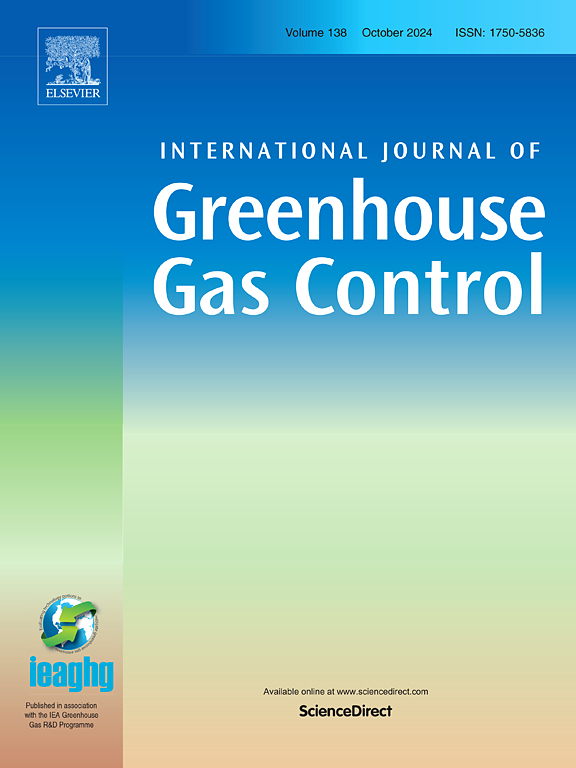超临界CO2、压力和温度对软盖泥岩声学和力学性质的影响
IF 5.2
3区 工程技术
Q2 ENERGY & FUELS
International Journal of Greenhouse Gas Control
Pub Date : 2025-09-01
DOI:10.1016/j.ijggc.2025.104459
引用次数: 0
摘要
储层中二氧化碳的安全储存取决于盖层的密封效率和机械完整性。为了长期封存二氧化碳,了解二氧化碳与盖层相互作用导致的岩石性质变化是至关重要的。在北海东南部,潜在的可开采和可渗透的二氧化碳储层包括中新世砂岩,其顶部覆盖的泥岩应该起到密封的作用。在这里,我们将丹麦北海Lille John-2井中新世上部盖层泥岩暴露在具有现场代表性的压力和温度条件下的超临界CO2环境中,以模拟实验室环境中CO2封存的效果。我们研究了CO2暴露前后岩石的声学、力学和化学变化,这对于了解盖层的强度和完整性至关重要。为了隔离地球化学效应,一组对照样品在等效压力和温度条件下暴露于惰性ar气体中。采用连续波法和穿透透射法测量切割尺寸(直径15 mm,厚度3-5 mm)试样的声速,采用冲孔法测定剪切强度。x射线衍射研究记录了化学驱动的矿物学变化。暴露后,材料的纵波速度和横波速度以及抗剪强度分别提高了约10%,10 - 50%和85 - 130%。然而,在矿物学上没有发现明显的变化。暴露于scCO2会使孔隙流体从样品中排出,导致强度和刚度增加,这可能是由于孔隙流体干燥造成的。scCO2、ar气和温度处理对个体的影响不明确。本文章由计算机程序翻译,如有差异,请以英文原文为准。
The effect of supercritical CO2, pressure, and temperature on the acoustic and mechanical properties of soft caprock mudstone
Safe storage of carbon dioxide (CO2) in a reservoir depends on the caprock's sealing efficiency and mechanical integrity. For long-term containment of CO2, knowledge of rock property alterations due to CO2-caprock interaction is crucial. Potentially accessible and permeable reservoirs for CO2 storage in the southeastern North Sea include Miocene sands, which are topped by mudstones that should act as seals. Here, we expose upper Miocene caprock mudstone recovered from the Lille John-2 well in the Danish North Sea to supercritical CO2 at field-representative pressure and temperature conditions to simulate the effect of CO2 sequestration in a laboratory setting. We investigate acoustic, mechanical, and chemical variations in the rock before and after CO2 exposure, which are essential for understanding the caprock’s strength and integrity. To isolate the geochemical effects, a control set of samples was exposed to inert Ar-gas under equivalent pressure and temperature conditions. The acoustic velocities were measured on cutting-sized (diameter:15 mm, thickness: 3–5 mm) samples using the continuous wave and through-transmission techniques, while shear strength was determined by the punch method. X-ray diffraction studies recorded chemically driven mineralogical alterations. After exposure, both compressional and shear wave velocities, as well as the shear strength of the material, increased by about 10 %, 10–50 %, and 85–130 %, respectively. However, no considerable change in mineralogy was detected. Exposure to scCO2 displaced pore fluid out of the samples, leading to increased strength and stiffness, possibly due to pore fluid drying. The individual impacts of scCO2, Ar-gas, and temperature treatment were ambiguous.
求助全文
通过发布文献求助,成功后即可免费获取论文全文。
去求助
来源期刊
CiteScore
9.20
自引率
10.30%
发文量
199
审稿时长
4.8 months
期刊介绍:
The International Journal of Greenhouse Gas Control is a peer reviewed journal focusing on scientific and engineering developments in greenhouse gas control through capture and storage at large stationary emitters in the power sector and in other major resource, manufacturing and production industries. The Journal covers all greenhouse gas emissions within the power and industrial sectors, and comprises both technical and non-technical related literature in one volume. Original research, review and comments papers are included.

 求助内容:
求助内容: 应助结果提醒方式:
应助结果提醒方式:


